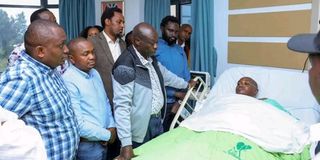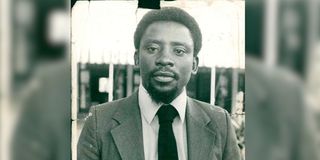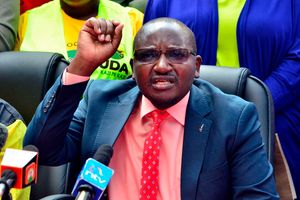
Former President Daniel Arap Moi and President William Ruto.
The broad daylight abduction of Juja MP George Koimburi has not only jolted the nation but also resurrected memories of the repressive post-1982 coup era, when paranoia gripped the Nyayo regime.
In the wake of the Gen-Z wave of anti-budget protests, it now appears that President Ruto’s Kenya Kwanza administration is opting for abductions, kidnappings, and enforced disappearances as political tools to instill fear and suppress dissent.
Mr Koimburi’s abduction, as he left church, came two weeks after the President promised, during a joint press conference with visiting Finnish President Alexander Stubb, that there would be no more abductions and extra-judicial killings.

Former Deputy President Rigathi Gachagua and other political leaders visit Juja MP George Koimburi at Karen Hospital on May 26, 2025.
That the government has now embraced the very tactics it once condemned during the campaigns, methods used by successive governments since independence to silence dissent, is both ironic and alarming.
While Jomo Kenyatta relied on detention without trial and political assassinations to silence his critics, most notably the 1975 murder of Nyandarua North MP JM Kariuki, Daniel arap Moi inherited and expanded these authoritarian tactics, going further by institutionalising torture as a central tool for suppressing dissent and consolidating power.
Detention without trial
This escalation came in the wake of mounting criticism from human rights organisations. Although Moi had initially pledged not to resort to detention without trial, his tone, had, by mid-1981 shifted.
John Keen, a former detainee himself and then serving as an Assistant Minister in the Office of the President, publicly declared that the reintroduction of detention was, in his view, a necessary deterrent against the growing civil unrest. Keen was effectively testing public sentiment on behalf of an increasingly frustrated president.
The attempted coup, like the Gen Z uprisings, brought profound changes in the workings of the Nyayo regime. As Jeremiah Kiereini, the head of civil service, recalled in his autobiography “powerful politicians in Moi’s government began interfering with the civil service, influencing appointments and compromising the professional system and its functional stability….at some point, the President stopped consulting me on important matters.”
Within the Ruto administration, powerful figures have emerged, who wield significant influence over the state apparatus and openly support strong-arm tactics. These power centres appear to revolve around two key individuals: Chief of Staff Felix Koskei and the President’s Personal Assistant, Farouk Kibet.
Ironically, while President Moi once deployed state machinery to silence Raila Odinga, then Deputy Director at the Kenya Bureau of Standards, President Ruto's regime now appears to be working with Mr Odinga to contain opposition voices and neutralise critics.
In the 1980s, the Moi government curtailed dissent by seizing the passports of radical politicians such as Oginga Odinga, Mashengu wa Mwachofi, James Orengo, Achieng Oneko, and Abuya Abuya, effectively restricting their movement and silencing international advocacy. Oginga Odinga was even placed under house arrest as part of Moi’s broader strategy to isolate him from his political base and stifle opposition.
Detentions continued unabated: Koigi wa Wamwere and law lecturer Willy Mutunga—who would later become Chief Justice—were detained in August 1982, becoming the eighth and ninth individuals imprisoned in the post-coup purges. Academic Maina wa Kinyatti received a six-year jail sentence for merely possessing anti-government pamphlets, while journalists critical of the regime were also arrested and jailed. The paranoia extended to the Judiciary, where legal proceedings increasingly served political ends.
When Orengo skipped bail, fled the country
In November 1982, Orengo, facing charges of forgery and theft, skipped bail and fled the country. Fellow MP Onyango Midika was convicted of theft, but evidence presented during his trial suggesting he had celebrated the coup likely played a role in securing his conviction. Also detained in the post-coup attempt purges was Raila Odinga who spent five years in prison.

James Orengo in his youth.
Between March 1986 and March 1987, Moi intensified his crackdown on dissent, and at least 75 individuals—journalists, academics, students, and peasants—were jailed on charges ranging from sedition to the mere possession of banned Mwakenya and Mpatanishi literature. The majority of those targeted were from Nyanza region and Central Kenya.
Like in the case of Gen Z’s, many were detained illegally, held for weeks or months without trial, and subjected to brutal torture by Special Branch officers. Some did not survive. The basement of Nairobi’s Nyayo House, where many of the detainees were taken, became infamous for its flooded, windowless cells. These were hidden chambers where captives were stripped, beaten, and left naked without food or water. While routine government operations continued on the upper floors – and government denied that torture was taking place - the building's twenty-fourth floor served as an interrogation site, where detainees were tortured through beatings, burnings, and physical assault. The interrogations were reportedly led by an officer known as Muchiri and Superintendent James Opiyo, an associate of powerful administrator Hezekiah Oyugi.
It is now known that these secret facilities were constructed in the aftermath of the 1982 coup attempt, when a paranoid Nyayo administration ordered modifications to the design of Nyayo House, which was still under construction at the time. By the time the new Nairobi Provincial Headquarters was officially opened in 1983, few could have suspected that its basement concealed torture chambers. Their existence only came to light after President Moi left office.
Within State House, President Moi also modified his inner circle. As Andrew Morton in Moi’s biography, “ the days of easygoing camaraderie and collective decision-making, a reflection of his Tugen heritage, abruptly ended.”
Wrote Morton: “A necessary distance was deliberately built up between the President and those who sought to control his thoughts and actions. Unqualified trust gave way to scepticism and suspicion. Charles Njonjo, G.G. Kariuki and other confidants could no longer wander into State House and see the President. Now ministers could only meet him after making an appointment, and then only to discuss official business.”
While the 1982 coup significantly altered the political landscape and used state apparatus to exert fear, it now appears that the Gen Z uprisings have left President Ruto in the same predicament that once faced Moi. As murmurs of a “one-term presidency” grow louder, the State machinery seems to be tracing Moi’s footsteps—resorting to intimidation, abductions, and silencing of dissent to contain rising public anger and tame opposition voices.
The abduction of the Juja MP was not just a chilling message to political dissenters; it was a stark warning that the architecture of fear is being rebuilt in the shadows of power. History appears to repeat itself—not as a lesson, but as a tragedy.







